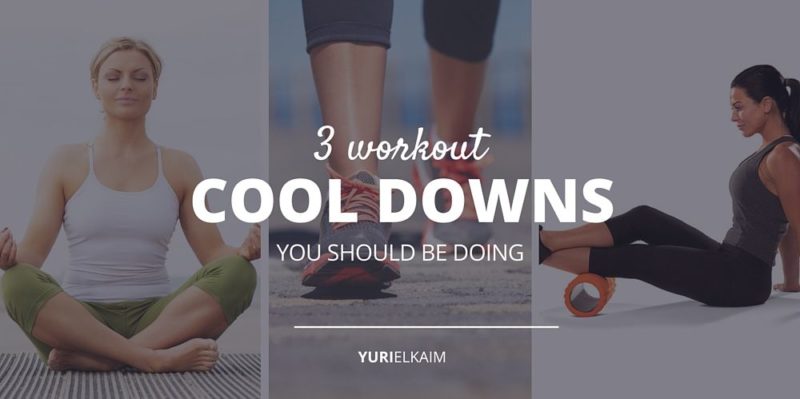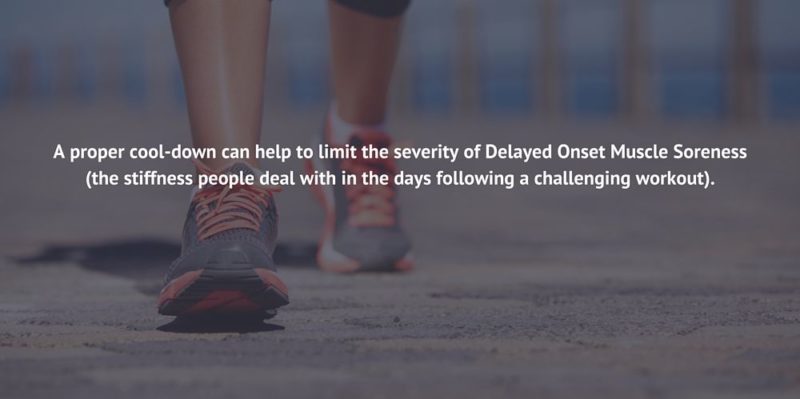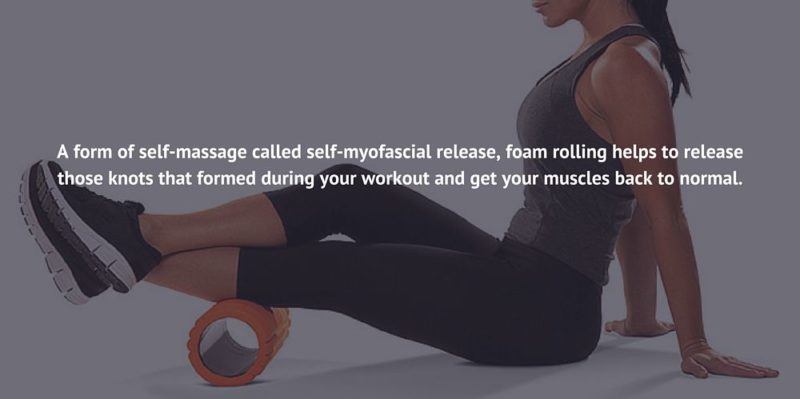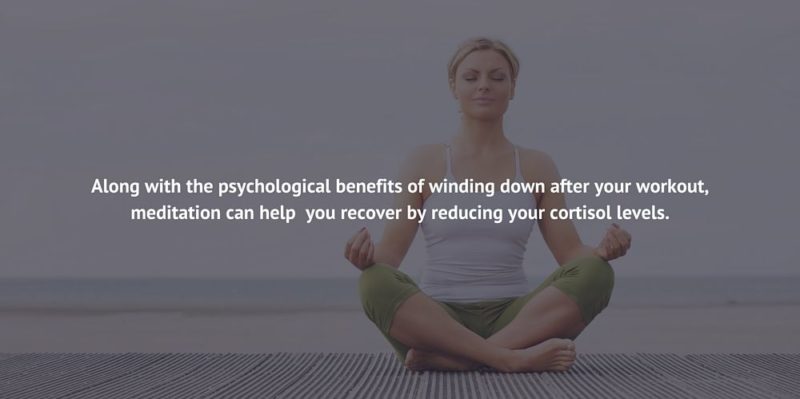In this article
I get it: There are times when it takes all your self-discipline to carve out even a minimum of workout time in your schedule.
But don’t let being in a time crunch stop you from including a vital step that should end every exercise session. Properly constructed, workout cool downs deliver tons of benefits and can complement the rest of your fitness routine by making your next workout better.
Why? Because it’s all about that workout recovery.
Why Workout Cool Downs Matter
I know that when you’re time-strapped, it can seem counterintuitive to “waste” time at the gym doing something that doesn’t seem very vigorous.
I’m going to explain the purpose of the cool down – and what you want to be focused on when designing an effective cool down – and why it’s so critical for workout recovery.
When you exercise, your body is actually undergoing stress and even incurring some damage.
That might seem like a strange thought. But that stress and damage is exactly what you want to happen.
Exposing your body to those stimuli lets your brain know that some changes need to be made – your muscles need to be stronger and faster – so that the activity isn’t such a challenge next time.
It’s all about creating an environment in which your body can adapt.
But, sometimes, people work out – sending those “faster-stronger” signals to the brain – and then they don’t allow those adaptations to take place.
Without proper recovery, your body isn’t able to rebuild and repair your muscles the way that it should, limiting the benefits you will see from all your hard work in the gym.
Denying your body adequate recovery won’t just slow down your results. It’s downright counterproductive.
As an example, what would happen if you took the old oil out of your car and, instead of funneling in new, clean, more efficient oil, you try to force it to run with nothing?
Things aren’t going to go well.
Working out without allowing your body to fully recover is essentially the same thing. You’re putting your body under stress – even doing some damage – and then requiring it to keep working at the same high level.
In this state – called overtraining – your body now feels like the situation is worse than it originally thought, and goes into high-stress mode (1).
Of particular concern here is the so-called “stress hormone” cortisol which, when you’re in overtraining mode, is produced in massive concentrations.
Normally, cortisol is handy – increasing your energy level, improving mental focus, and even encouraging the use of fat for fuel.
When levels get too high, however, the opposite happens. Fat storage is encouraged, muscle is turned on for fuel, and your cognitive function can plummet.
A well-designed cool down, however, is the first step toward proper workout recovery.
Obviously, avoiding overtraining involves checking your overall workout and diet routine, but building a good cool-down habit is the first step.
Constructing Cool Downs for Workouts
You may have noticed, however, that there was a pretty major caveat mentioned at the outset.
Specifically, I talked about a “proper” cool down for workouts.
To give you a better idea of what that actually means, let’s go through three steps that most gym goers neglect but that should absolutely be part of your closing ceremonies at the gym.
Used together, these three stages target all of the recovery goals that a workout cool down should accomplish.
1. Light Movement
Probably the most obvious form of cool down is simply to keep moving but at a reduced intensity. This could include something as basic as a 5- to 10-minute walk after you’ve finished your regularly scheduled program.
While it might seem a little boring, this cool down technique is important.
Here’s an example why: During exercise, your heart is hard at work pumping blood throughout your body. As you work, your muscles contract to help facilitate that movement. If you stop moving abruptly blood can find itself stranded in your extremities – especially in your legs.
With all that blood pooled at the fringes of your heart’s reach, it’s going to take some time for your circulatory system to regain control and restore proper blood flow.
In the meantime, certain important organs – like your brain – are a little neglected. This pooling is responsible for the lightheadedness and even fainting that some people experience after they workout.
Taking a few minutes to just gradually slow down basically reacclimates your body to the standard pace of life.
And some light movement after your more demanding exercise can also help to reduce muscle soreness, helping you recover faster.
In general, the primary culprit for the stiffness that people deal with in the days following a challenging workout is a phenomenon know as Delayed Onset Muscle Soreness (DOMS).
A natural part of the body’s repair process, DOMS is a sign that your muscles are getting stronger. Unfortunately, it can also be uncomfortable and painful.
According to a 2012 study conducted at California State University, however, a proper cool-down can help to limit the severity of DOMS (2).
For the study, 26 women were all put through a strenuous workout, specifically designed to cause DOMS in there quadriceps. The women then either wrapped up their workouts by cycling at moderate intensity, cycling at low intensity or doing nothing.
At the end of the study, the moderate intensity cycling group experienced significantly less soreness than the other groups.
In all likelihood, this is caused by the increased blood flow to the affected muscles that the cycling would have stimulated.
Finally, some light activity also helps to flush lactic acid from your system. While modern research has found that lactic acid is not the cause of muscle soreness as was once thought, too much of it can still be a problem (3).
As we now know, lactic acid is actually a valuable muscular fuel – it just takes some time for your body to use it and prevent a build up.
Light activity, however, helps our body both get that lactic acid out of the blood stream and burn it as fuel. Interestingly, one study in gymnasts found that using “active recovery” (light movement between exercises) not only reduced soreness but also improved performance thanks to the increased fuel (4).
Moving that lactic acid around after your workout, then, will help to cut down any burning you may be feeling in your muscles. This type of cool-down will also cause you to use that lactic acid for fuel, restoring your energy levels.
2. Foam Rolling
For years, the common wisdom was that the best thing you could do after a workout is run through a series of static stretches.
And as a result, in PE classes around the world, students to stretch out their muscles after each workout.
Unfortunately, this probably isn’t the best idea. As mentioned, your muscles and connective tissues go through all sorts of stress during your workouts. And as a result, they tighten up in ways that stretching doesn’t fix.
Just to illustrate this, imagine a knot tied in a rubber band. What would happen if you pulled on the band, stretching it out? That knot is probably just going to get tighter. It’s definitely not getting untied.
This is pretty much what happens inside your muscles. And static stretching, while it’s a great tool for increasing flexibility, cannot work out the knots.
Foam rolling, however, can. Essentially a form of self-massage called self-myofascial release, foam rolling helps to release those knots that formed during your workout and get your muscles back to normal.
One study in the journal Medicine and Science in Sports and Exercise found that foam rolling not only reducing muscle soreness but can even improve exercise performance by increasing recovery (5).
Check out this post for 5 awesome foam roller exercises.
3. Meditation
Perhaps the most commonly overlooked form of cool down, meditation is a perfect way to help your body and mind recover from the challenges of your workout.
There are many different types of meditation but the general idea is to relax your mind and increase your overall sense of awareness. Typically, this is done through controlled breathing – something that can easily be incorporated into your newly-forming cool-down routine.
How does post-exercise meditation help you cool down from your workout?
Along with the psychological benefits of winding down after your workout, meditation can help you recover by reducing your cortisol levels.
Remember, when concentrations of this otherwise helpful hormone get too high, your body starts to actively work against your health and fitness goals.
And exercise happens to be one of the things that increases cortisol levels. Meditation, however, greatly reduces feelings of stress and brings cortisol levels back down to healthy levels (6).
Your Next Workout Will Be Even Better
When you deploy these three workout cool down techniques into your regimen, you’ll be setting yourself up for success.
You’ll be helping to return your body back to “normal” while preventing muscle soreness; getting rid of any knots and improving/restoring flexibility; and reducing the effects of the stress caused by the workout.
And you likely will find that you return to the rest of your day feeling renewed and energized – and your body will be more ready than ever to tackle the next workout.
Want More Cool Down?
Workout recovery is a huge buzzword right now – for good reason. How you end your workout has a tremendous impact on your next workout (and also the time between). Check out 11 little-known strategies to boost your recovery in my FREE download, Workout Recovery Formula, which you can get now by clicking the banner below.




